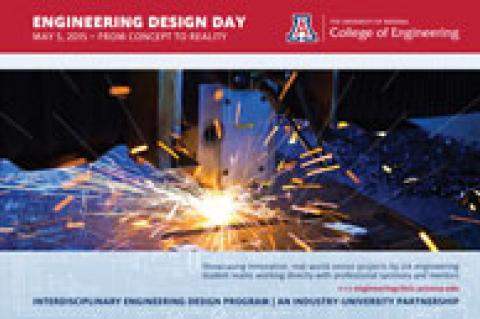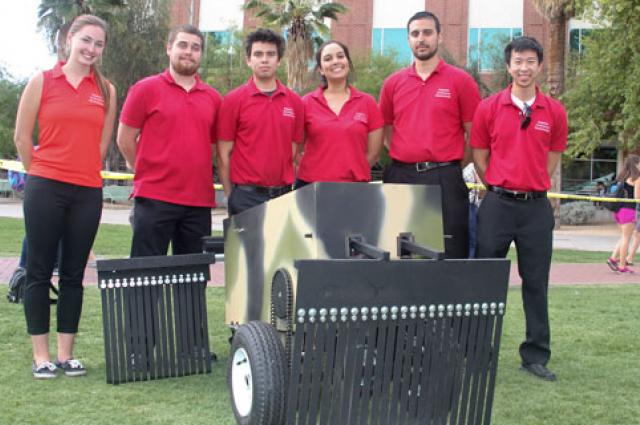UA Engineering Seniors Pull Out All the Stops at Engineering Design Day 2015
A whirlwind of creativity, innovation and excitement marked the 13th Annual Engineering Design Day on the University of Arizona campus May 5 as 80 senior design teams competed for $20,000 in prizes.

Top prizes for best overall design went to a robot protecting soldiers from “toe poppers” and to a system for keeping biomedical samples on slides at a controlled temperature.
Some 45 sponsors from industry, academia and government supported the teams of seniors, who displayed their projects on the UA Mall and in the Student Union.
Attendees included 90 judges from sponsoring organizations; UA faculty; several groups of middle-school students from the Tucson Unified School District; and participating seniors’ family members and friends, many from out of state.
“I was so pleased to be able to get a glimpse of the talent that UA Engineering students have at Design Day," said University of Arizona President Ann Weaver Hart. "The event is a wonderful example of the way that UA Engineering students apply what they have learned in a realistic setting. Through opportunities to interact with industry, community organizations, and K-12 students, this day and the work leading up to it help to fulfill the University of Arizona’s commitments to 100 percent student engagement and partnership.”
Protecting Soldiers on Patrol
First prize for overall best design, sponsored by Raytheon Sensintel, went to the team that created the Robotic Ordnance Neutralizer, or RON, sponsored by Raytheon Missile Systems. Team members were Elisa Duarte, Jeremy Gin, Jaime Lara Martinez, Mark Roche, Cassandra Kammerman and Greg Stanford.
The robot triggers small, hard-to-find improvised explosive devices -- known as “toe-poppers” for their low explosive charge -- in the paths of soldiers on patrol.
The unmanned ground vehicle system is designed to detonate hidden IEDs by applying a certain pressure to the ground as it moves along ahead of military personnel.
Like in real life, many of the design teams faced challenges. For example, delays in parts shipments forced the winning team to improvise.
“There were trade-offs. Our RON goes slower -- only about 2 to 3 mph -- but at no cost to mobility or steering,” said systems engineering student Elisa Duarte. Duarte is spending this summer at her second internship with Raytheon before starting the master’s program in management science and engineering at Stanford.
“This award means the world to me, because I know all the work that went into it and all the roadblocks we faced.”
Download a PDF guidebook describing every project on display at Engineering Design Day 2015
Read the Design Day guidebook online here.
Watch a Design Day video here.
Second prize for overall design went to the super-stainer precision thermal control. Team members from biomedical, industrial, mechanical and electrical engineering developed a system for Ventana that can hold a standard-size microscope slide and maintain its temperature to precise specifications.
Other big winners included a drone to monitor transmission lines for Tucson Electric Power; a system to diagnose equine health by monitoring hoof condition; and hologram-based headgear for pilots to safely land aircraft at zero visibility.
More than 6,000 individual users from several countries tuned in to Facebook throughout the day to follow the action and cheer on their teams.
College of Engineering Dean Jeff Goldberg expressed admiration for the students’ perseverance and fortitude, and gratitude to the sponsoring organizations, judges, faculty and other mentors and staff who made the event possible.
“In nine months, it’s not so easy to get something fully functional that can be put into use,” he said. Noting that the cost of the projects this year was half a million dollars, he thanked the judges, company sponsors, faculty and staff, adding, “Without you, we would not be able to do something of this magnitude.”
Engineering Design Day 2015 Slide Show
Design Day 2015 Awards and Winners
Raytheon Sensintel Best Overall Design, First Prize • $1,000
Robotic ordnance neutralizer (RON)
Design team: Elisa Duarte, Jeremy Gin, Cassie Kammerman, Mark Roche, Greg Stanford,
Jaime Lara Martinez
Project sponsor: Raytheon Missile Systems
Raytheon Sensintel Best Overall Design, Second Prize • $750
Super-stainer precision thermal control
Design team: Marissa Lopez-Pier, Amy Vaughn, Ziad Alrayes, Cody Kalmick, Koriel Lambson, Chris Sanford
Project sponsor: Ventana Medical Systems
Bly Family Innovation in Energy Production, Supply or Use, First Prize • $1,500
Building a smarter grid
Design team: Jacob Chess, Peter Lankisch, Viviana Llano, Daniel McLeod, Alex Moser, Eric Sahr
Project sponsor: Tucson Electric Power
Bly Family Innovation in Energy Production, Supply or Use, Second Prize • $500
Dynamic soaring of UAVs
Design team: Katherine Borg, Elizabeth Yakoob, Brent Reichert, Aaron Woodard
Project sponsor: UA department of aerospace and mechanical engineering
Thorlabs Photonics Is the Future • $1,500
Automated optical surface defect detection tool
Design team: Shabeeb Shah, Benjamin Cromey, Lisa Li, Nicholas Smith, Rafael Haro, Michael McDermott
Project sponsor: Edmund Optics
Rincon Research Best Presentation • $1,000
Electromechanical shaft disconnect for generators
Design team: Jose Luttmann, Isaiah Bruno, Michel Mora, Ivy Hasman
Project sponsor: Honeywell
Texas Instruments Analog Design Contest • $1,000
Strain gauge based cycling power meter
Design team: Tasia Nash, Vincent Carknard, Adam Osman, Vincent Hunt, Cameron Clementson
Project sponsor: Texas Instruments
Ventana Innovation in Engineering • $1,000
Sabino Canyon VTOL UAV
Design team: Rita Ezeugwu, Nestor Franco, Nicolle Hervey, Youra Jun, Sean Parker, Steven Rishor, Yiming Zhang
Project sponsor: Rincon Research Corp.
ACSS/L-3 Communications Most Robust Systems Engineering • $750
Boeing teammate awareness device
Design team: Amanda Coldren, Vincent Cordasco, Anthony Giang, David Schwartz, Xue Meng, Matthew Ware
Project sponsor: Boeing Mesa Helicopter Company
CAID Industries Innovation in Manufacturing • $750
X-56A DART: Dynamically scaled aircraft for research and testing
Design team: Phillip Greenberg, Brianna Grembowski, Harry Powell, Rosanna Bether, Kristofer Drozd
Project sponsors: NASA, Lockheed-Martin, Air Force Office of Scientific Research
Edmund Optics Perseverance and Recovery • $750
Advanced farrier system
Design team: Lindsay Bahureksa, Lindsey Conklin, Matt Ellison, Jacob Landsiedel, Quinn McIntosh, Jovan Vance
Project sponsor: Brethren Systems
W.L. Gore and Associates Most Creative Solution • $750
Variable-pitch propeller for UAVs
Design team: Kym Beeston, Grant Province, Zane Sheets, Zach Spaulding, Chris Van Cleave, Jeff Williams
Project sponsor: Northrop Grumman
PADT Best Use of Prototyping • $750
Delivery of an endovascular device for a bifurcating vascular anatomy
Design team: Andrea Acuna, Carmelo Moraila, Marysol Luna, Matthew Davis, Matthew Kirk, Sean Ashley
Project sponsor: UA Soft Tissue Biomechanics Lab
Raytheon Best Engineering Analysis • $750
Wireless flow sensor for cerebrospinal fluid shunts
Design team: Brianna Moon, Han Zhao, Jessica Mergener, LaRay Graner, Lyndsay Batman, Megan Cornman
Project sponsor: Texas Instruments
Sargent Aerospace & Defense Voltaire Design • $750
Advanced farrier system
Design team: Lindsay Bahureksa, Lindsey Conklin, Matt Ellison, Jacob Landsiedel, Quinn McIntosh, Jovan Vance
Project sponsor: Brethren Systems
Technical Documentation Consultants of Arizona Best Design Documentation • $750
Remote imaging system acquisition (RISA) project
Design team: Luis Ballesteros, Nicole Sheesley, Braden Smith, Joseph Tang, Yusuke Watanabe
Project sponsor: NASA Johnson Space Center
TRAX International Best Implementation of Agile Methodology • $750
Design of multistory historical LEED building
Design team: Mireya Moleres, Joel Amarillas, Haley Koesters, Nawar Sadeq, Gabriela Brambila, Blake Brennan
Project sponsor: UA department of civil engineering and engineering mechanics
Arizona Center for Innovation Most Marketable Design • $500
Smartphone integrated gun lock
Design team: Ariel Austin, Aaron Clark, Christopher Downs, Edward Enhelder, Aaron Grabowska, Simon Noudelman
Project sponsor: Christopher J. Downs & Associates
Dataforth Corporation Best Design Using a Data Acquisition and Control System • $500
A method for the morphing actuation of continuous control surfaces
Design team: Austin Smith, Ruben Adkins, Josef Merki, Zachary Miller, David Springer, Wen Quan Tan
Project sponsor: UA Student Chapter of American Institute of Aeronautics and Astronautics
Honeywell Team Leadership 1 • $250
Delivery of an endovascular device for a bifurcating vascular anatomy
Design team: Andrea Acuna (winner), Carmelo Moraila, Marysol Luna, Matthew Davis, Matthew Kirk, Sean Ashley
Project sponsor: UA Soft Tissue Biomechanics Lab
Honeywell Team Leadership 2 • $250
Design and demonstration of a head-up display
Design team: Erick Leon (winner), Adam Blumer, Matthew Hart, Michael Green, Nick Paco, Stephania Vasilieva
Project sponsor: Honeywell Aerospace
II-VI Optical Systems Best Use of Optical Design and Technology • $500
Design and demonstration of a head-up display
Design team: Adam Blumer, Erick Leon, Matthew Hart, Michael Green, Nick Paco, Stephania Vasilieva
Project sponsor: Honeywell Aerospace
Latitude Engineering Best Physical Implementation of Analytically Driven Design • $500
Composite autotransformer thermal improvement
Design team: Ji Ma, Michael McCabe, John McKearney, Zachary Prince, Erik Wise
Project sponsor: Honeywell Aerospace
Universal Avionics Best Integration and Test Philosophy • $500
Air quality sensor system
Design team: Rodrigo Toler, Mary Coffelt, Wellington Lee, Toshifumi Tanabe, Edward Baumann
Project sponsor: Honeywell Aerospace
UA Center on Aging: Arizona Center on Gerimetrics • $500
Android platform hearing assist device refinement and form factor & usability assessment
Design team: Temesgen Fesahazion, Richard Gonzales, Alexandra Hoeger, Saradadevi Thanikachalam, Jill Wynne, Jue Zhang, Michael Ziccarelli
Project sponsor: Arizona Center on Aging
Honeywell Excellence in Aerospace Electronic System Design • $400
Design and demonstration of a head-up display
Design team: Adam Blumer, Erick Leon, Matthew Hart, Michael Green, Nick Paco, Stephania Vasilieva
Project sponsor: Honeywell Aerospace
Kristy Pearson Fish Out of Water, First Prize • $250
Composite autotransformer thermal improvement
Design team: John McKearney (winner), Ji Ma, Michael McCabe, Zachary Prince, Erik Wise
Project sponsor: Honeywell Aerospace
Kristy Pearson Fish Out of Water, Second Prize • $150
Air quality sensor system
Design team: Mary Coffelt (winner), Rodrigo Toler, Wellington Lee, Toshifumi Tanabe, Edward Baumann
Project sponsor: Honeywell Aerospace
Top picture: Robotic ordnance neutralizer team members stand by their bomb-disposal robot at UA Engineering Design Day 2015. The team won the $1,000 Raytheon Sensintel Best Overall Design, First Prize.


